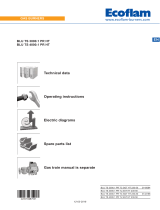
1 20145931
Contents
1 Declarations................................................................................................................................................................................ 3
2 Information and general warnings............................................................................................................................................ 4
2.1 Information about the instruction manual .................................................................................................................... 4
2.1.1 Introduction.................................................................................................................................................................. 4
2.1.2 General dangers.......................................................................................................................................................... 4
2.1.3 Other symbols ............................................................................................................................................................. 4
2.1.4 Delivery of the system and the instruction manual...................................................................................................... 5
2.2 Guarantee and responsibility....................................................................................................................................... 5
3 Safety and prevention................................................................................................................................................................ 6
3.1 Introduction.................................................................................................................................................................. 6
3.2 Personnel training ....................................................................................................................................................... 6
4 Technical description of the burner ......................................................................................................................................... 7
4.1 Burner designation ...................................................................................................................................................... 7
4.2 Models available.......................................................................................................................................................... 7
4.3 Burner categories - Countries of destination ............................................................................................................... 8
4.4 Technical data ............................................................................................................................................................. 8
4.5 Electrical data.............................................................................................................................................................. 8
4.6 Maximum dimensions.................................................................................................................................................. 9
4.7 Burner equipment........................................................................................................................................................ 9
4.8 Firing rates ................................................................................................................................................................ 10
4.9 Test boiler.................................................................................................................................................................. 11
4.9.1 Commercial boilers.................................................................................................................................................... 11
4.10 Burner description ..................................................................................................................................................... 12
4.11 Electrical panel description........................................................................................................................................ 13
4.12 Control box RFGO-A22............................................................................................................................................. 14
4.13 Servomotor (SQN31...).............................................................................................................................................. 15
5 Installation ................................................................................................................................................................................ 16
5.1 Notes on safety for the installation ............................................................................................................................ 16
5.2 Handling .................................................................................................................................................................... 16
5.3 Preliminary checks .................................................................................................................................................... 16
5.4 Operating position ..................................................................................................................................................... 17
5.5 Preparing the boiler ................................................................................................................................................... 17
5.5.1 Boring the boiler plate ............................................................................................................................................... 17
5.5.2 Blast tube length........................................................................................................................................................ 17
5.5.3 Securing the burner to the boiler ............................................................................................................................... 17
5.6 Access to head internal part...................................................................................................................................... 18
5.6.1 Combustion head pre-calibration .............................................................................................................................. 18
5.7 Positioning the probe - electrode............................................................................................................................... 18
5.8 Combustion head adjustment.................................................................................................................................... 19
5.9 Gas supply ................................................................................................................................................................ 20
5.9.1 Gas feeding line ........................................................................................................................................................ 20
5.9.2 Gas train.................................................................................................................................................................... 21
5.9.3 Gas train installation.................................................................................................................................................. 21
5.9.4 Gas pressure............................................................................................................................................................. 21
5.10 Electrical connections................................................................................................................................................ 23
5.10.1 Supply cables and external connections passage .................................................................................................... 23
5.11 Calibration of the thermal relay ................................................................................................................................. 24
5.12 Motor rotation ............................................................................................................................................................ 24
6 Start-up, calibration and operation of the burner ................................................................................................................. 25
6.1 Notes on safety for the first start-up .......................................................................................................................... 25
6.2 Adjustments prior to ignition ...................................................................................................................................... 25
6.3 Servomotor adjustment ............................................................................................................................................. 25
6.4 Burner start-up .......................................................................................................................................................... 26
6.5 Burner ignition ........................................................................................................................................................... 26
6.5.1 Burner adjustment..................................................................................................................................................... 26
6.5.2 Ignition output............................................................................................................................................................ 26
























